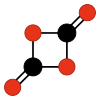
| |

| |
| Names | |
|---|---|
| Preferred IUPAC name
1,3-Dioxetane-2,4-dione[1] | |
| Other names
Dicarbonic anhydride
| |
| Identifiers | |
3D model (JSmol)
|
|
| ChemSpider | |
PubChem CID
|
|
CompTox Dashboard (EPA)
|
|
| |
| |
| Properties | |
| C2O4 | |
| Molar mass | 88.018 g·mol−1 |
Except where otherwise noted, data are given for materials in their standard state (at 25 °C [77 °F], 100 kPa).
| |
The chemical compound 1,3-dioxetanedione, or 1,3-dioxacyclobutane-2,4-dione, also known as dicarbonic anhydride, is a hypothetical oxide of carbon with formula C2O4. It can be considered a cyclic dimer of carbon dioxide (CO2) or as a double ketone of 1,3-dioxetane (1,3-dioxacyclobutane).
Theoretical calculations indicate that the compound would be extremely unstable at room temperature (half-life of less than 1.1 μs) but may be stable at −196 °C.[2]
YouTube Encyclopedic
-
1/1Views:40 961
-
Vapor Activated Glow Stick
Transcription
References
- ^ "CID 17801328 - Compound Summary". PubChem Compound. USA: National Center for Biotechnology Information. 4 December 2007. Identification and Related Records. Retrieved 7 October 2011.
- ^ Errol Lewars (1996), Polymers and oligomers of carbon dioxide: ab initio and semiempirical calculations. Journal of Molecular Structure: THEOCHEM, Volume 363, Number 1, pp. 1–15.
